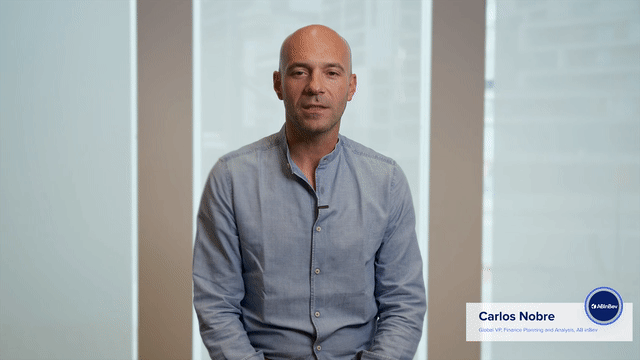
Explore Industry Research
What do Gartner, Forrester, and IDC have in common? They all named Anaplan a planning leader.

We not only have a financial plan with a number, but we know which actions we need to take to make sure that plan, and that number, actually materialize.— Carlos Nobre, Global VP, Finance Planning and Analysis, AB InBev
time savings in company-wide data consolidation accelerates decision-making
iteration enables leaders to evaluate multiple scenarios and drive action
planning platform shared across the company supports consistent planning and better information flow
AB InBev, the largest brewing company in the world, is the home of many beloved beer brands including Budweiser, Corona, and Stella Artois. “We have brought together many brands and created a lot of value for our customers,” notes Carlos Nobre, Global VP, Finance Planning and Analysis at AB InBev. “Our growth has also added complexity, which we need to manage in our planning cycles.”
That complexity extends beyond fact that 500+ brands operate under the AB InBev umbrella. External drivers — inflation, in particular — make financial agility important. But agility was hard to come by using traditional FP&A tools. “Planning season was a nightmare for us,” recalls Darya Boldyreva, FP&A Director. “We spent countless hours reconciling and consolidating spreadsheets and fixing mistakes.” Nobre agrees, adding that massive data volumes and legacy tools added to the challenge.
The planning challenges extended beyond finance. “In our company it's crucial to forecast revenues, costs, and ultimately net profit,” Boldyreva shares. “That requires supply chain planning, to make sure that we will have products in place on time to drive high service levels for our customers.”
AB InBev began crafting an Anaplan solution in 2016, starting with one finance use case. The footprint has expanded consistently since then, and the company now has some two dozen Anaplan use cases touching finance, supply chain, sales and marketing, and HR planning.
“We plan over a range of periods, with a certain level of financial planning associated with each horizon,” Nobre explains. “With Anaplan we can plan at very high level in our long-range planning cycles, and in granular levels when we do short-term planning.”
As the Anaplan solution at AB InBev has grown, the platform has become central to company operations. “Planning is essential so that we know where we're driving the company to,” Nobre says. “It ensures that our strategy is represented in our action plans, and that the action plans drive the financial results that we expect.”
The benefits that AB InBev sees from its Anaplan solutions are as substantial and diverse as the company itself. They include:
Boldyreva summarizes the benefits of AB InBev’s solution this way: “With Anaplan we know that all parts of the business are connected, and we are really confident in our plans.”
And although AB InBev’s planning ecosystem is already sophisticated and beneficial, Nobre believes that the company is just getting started. “I think there’s an immense amount of opportunities for us to tap into with Anaplan,” he says. “While we have done a lot, and improved a lot of our processes, there is much more to come.”
Carlos Nobre, Global VP, Financial Planning & Analysis: AB InBev is the largest brewer in the world and we make the finest beers. We are a large company, very complex. Some of them have different legacy systems, and Anaplan has helped us to get everything together in the same platform. And more importantly, is not only just to help us to consolidate, is also helping each one of them to plan differently and plan better.
Since we have implemented Anaplan at ABI, we have reduced the amount of time that it takes us to produce the same product that we used to have. But more importantly, the products are now better as well. Because we are able to integrate them, they are more accurate.
So our accuracy as well of our planning cycles has increased a lot as well as the actionability of our plans, so that now we [not] only have a financial plan with a number, but we also know which actions we need to take to make sure that that plan and that number actually materialize.
And I like to see also how the tool keeps evolving. While we have done a lot and we have changed a lot, our processes, there's much more to come.
My name is Carlos Nobre. I'm the head of Finance Planning and Analysis at AB InBev, and we plan with Anaplan.

